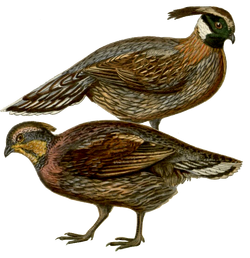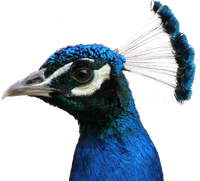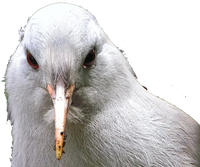| Koklass Pheasant[1] | |
|---|---|

| |
| Scientific classification | |
| Kingdom: | Animalia |
| Phylum: | Chordata |
| Class: | Aves |
| Superorder: | Galloanserae |
| Order: | Galliformes |
| Family: | Phasianidae |
| Subfamily: | Phasianinae |
| Tribe: | Tetraonini |
| Genus: | Pucrasia G.R. Gray, 1841 |
| Species: | P. macrolopha |
| Binomial name | |
| Pucrasia macrolopha (Lesson, 1829) | |
| Synonyms | |
|
Satyra macrolopha (protonym)[3] | |
Koklass Pheasant, Pucrasia macrolopha is a species of pheasant in the Tetraonini tribe. Despite the word pheasant in its name, it is closely related to grouses, but some authors put it in Lophophorini.[4]
It is the only species in the genus Pucrasia, but has nine subspecies grouped into three groups: Himalayan group, which includes macrolopha, castanea, biddulphi (with bethelae) and nipalensis, Golden-collared group, with xanthospila, meyeri and ruficollis, and Eastern group, including darwini and joretiana;[5]
| Click for other names | |
|---|---|
| Other common names | Koklas Pheasant, Koklass, Koklass Pheasant, Nepal Koklass[3] |
| Contents: |
|---|
|
Description • Subspecies • Similar species • Behaviour • Diet • Calls • Reproduction • Distribution/habitat • References • External links |
Desciption[]
A large, short-tailed pheasant,[6] with 58–64 cm (23–25 in) (tail 22–28 cm (8.7–11.0 in)), 1,135–1,415 g (2.502–3.120 lb);
52.5–56 cm (20.7–22.0 in) (tail 17–19.5 cm (6.7–7.7 in)), 930–1,135 g (2.050–2.502 lb).[5]
Males have a bottle green head, white neck patch, prominent ear-tufts with it lacking bare facial or wattle skin; has crown and long nuchal crest grey-buff.[6]
Subspecies[]
Himalayan group
|
Golden-collared group
|
Eastern group
|
Similar species[]
Behaviour[]
Diet[]
Calls[]
Reproduction[]
Distribution/habitat[]
From the Himalayas to China; steep slopes in coniferous and mixed forested mountains, at 600–1,900 metres (2,000–6,200 ft) in temperate zone.[6]
References[]
- ^ John H. Boyd III (September 26, 2011). "Galliformes Landfowl". TiF Checklist. Retrieved 19-04-2024. Check date values in:
|access-date=(help) - ^ "Pucrasia macrolopha". IUCN Red List of Threatened Species. Version 2013.2. International Union for Conservation of Nature. 2012. Retrieved 26 November 2013.
- ^ a b "Koklass Pheasant Pucrasia macrolopha (Lesson, 1829)". Avibase.
- ^ https://www.hbw.com/our-taxonomy#Phasianidae
- ^ a b (Subscription required) McGowan, P.J.K., Kirwan, G.M. & Boesman, P. (2018). Koklass Pheasant (Pucrasia macrolopha). In: del Hoyo, J., Elliott, A., Sargatal, J., Christie, D.A. & de Juana, E. (eds.). Handbook of the Birds of the World Alive. Lynx Edicions, Barcelona. (retrieved from https://www.hbw.com/node/53481 on 12 May 2018).
- ^ a b c Brazil, Mark (2009). Birds of East Asia: China, Taiwan, Korea, Japan, and Russia. Princeton University Press. ISBN 97801691139265 Check
|isbn=value: length (help).
External links[]
| Projects | ||||||||||
|---|---|---|---|---|---|---|---|---|---|---|
| ||||||||||





